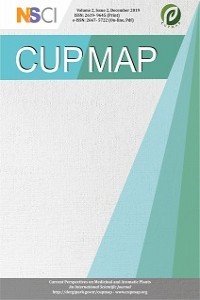Characterization and Optimization of Phytosome Formulation Containing Alcohol-free Umckalin from Pelargonium sidoides
Characterization and Optimization of Phytosome Formulation Containing Alcohol-free Umckalin from Pelargonium sidoides
Liposome, Phytosome, Umckalin, Pelargonium sidoides Characterization, Alcohol- free extract,
___
- 1. Agnich, L. E., Stogner, J. M., Miller, B. L., Marcum, C. D. (2013). Purple drank prevalence and characteristics of misusers of codeine cough syrup mixtures. Addictive behaviors, 38(9), 2445–2449. https://doi.org/10.1016/j.addbeh.2013.03.020.
- 2. Aslan, I. (2007) Plants and Cosmetics. Fitomed, 3, 49-51.
- 3. Awad, D., Tabod, I., Lutz, S., Wessolowski, H., Gabel, D. (2005). Interaction of Na2B12H11SH with liposomes: Influence on zeta potential and particle size. Journal of organometallic chemistry, 690(11), 2732-2735. https://doi.org/10.1016/j.jorganchem.2005.01.013.
- 4. Batista, Lilian R., Antoniosi Filho, Nelson R.. (2020). Ethanol Content Determination in Medicine Syrups Using Headspace and Multidimensional Heart-Cut Gas Chromatography Coupled to Mass Spectrometry. Journal of the Brazilian Chemical Society, 31(2), 394-401. Epub January 20, 2020. https://doi.org/10.21577/01035053.20190193.
- 5. Brendler T, van Wyk BE. A historical, scientific and commercial perspective on the medicinal use of Pelargonium sidoides (Geraniaceae). J Ethnopharmacol.b 2008;119(3):420‐433. https://doi.org/10.1016/j.jep.2008.07.037.
- 6. Colas, J. C., Shi, W., Rao, V. S., Omri, A., Mozafari, M. R., Singh, H. (2007). Microscopical investigations of nisin-loaded nanoliposomes prepared by Mozafari method and their bacterial targeting. Micron (Oxford, England : 1993), 38(8), 841–847. https://doi.org/10.1016/j.micron.2007.06.013.
- 7. Duman, G., Aslan, İ., Özer, A. Y., İnanç, İ., Taralp, A. (2014). Liposome, gel and lipogelosome formulations containing sodium hyaluronate. Journal of liposome research, 24(4), 259–269. https://doi.org/10.3109/08982104.2014.907305.
- 8. Ethemoglu, M. S., Seker, F. B., Akkaya, H., Kilic, E., Aslan, I., Erdogan, C. S., Yilmaz, B. (2017). Anticonvulsant activity of resveratrol-loaded liposomes in vivo. Neuroscience, 357, 12–19. https://doi.org/10.1016/j.neuroscience.2017.05.026.
- 9. Gunal, M. Y., Ayla, Ş., Bedri, N., Beker, M. Ç., Çağlayan, A. B., Aslan, İ. ... Kılıç, Ü. (2019). The effects of topical liposomal resveratrol on incisional and excisional wound healing process. Turkderm-Turkish Archives of Dermatology and Venerology, 53(4), 128-134. http://doi.org/10.4274/turkderm.galenos.2019.82612.
- 10. Kidd, P., & Head, K. (2005). A review of the bioavailability and clinical efficacy of milk thistle phytosome: a silybin-phosphatidylcholine complex (Siliphos). Alternative medicine review : a journal of clinical therapeutic, 10(3), 193–203. http://europepmc.org/abstract/MED/16164374.
- 11. Kohnen, W. (2007). Method for extracting plants of the genus Pelargonium sidoides extract produced according to said method, and use thereof. World PatentWO2007009446.
- 12. Kolodziej H. (2011). Antimicrobial, Antiviral and Immunomodulatory Activity Studies of Pelargonium sidoides (EPs® 7630) in the Context of Health Promotion. Pharmaceuticals (Basel, Switzerland), 4(10), 1295–1314. https://doi.org/10.3390/ph4101295.
- 13. Kolodziej, H., Kiderlen, A. F. (2007). In vitro evaluation of antibacterial and immunomodulatory activities of Pelargonium reniforme, Pelargonium sidoides and the related herbal drug preparation EPs 7630. Phytomedicine, 14 Suppl 6, 18–26. https://doi.org/10.1016/j.phymed.2006.11.020.
- 14. Kumar, R., Singh, B., Bakshi, G., & Katare, O. P. (2007). Development of liposomal systems of finasteride for topical applications: design, characterization, and in vitro evaluation. Pharmaceutical development and technology, 12(6),591–601. https://doi.org/10.1080/10837450701481181.
- 15. Lalli, J. Y. Y., Van Zyl, R. L., Van Vuuren, S. F., Viljoen, A. M. (2008). In vitro biological activities of South African Pelargonium (Geraniaceae) species. South African Journal of Botany, 74(1), 153-157. https://doi.org/10.1016/j.sajb.2007.08.011.
- 16. Lizogub VG, Riley DS, Heger M. Efficacy of a pelargonium sidoides preparation in patients with the common cold: a randomized, double blind, placebo-controlled clinical trial. Explore (New York, N.Y.). 2007 Nov-Dec;3(6):573-584. https://doi.org/10.1016/j.explore.2007.09.004.
- 17. Sharma D, Yadav JP. An Overview of Phytotherapeutic Approaches for the Treatment of Tuberculosis. Mini Rev Med Chem. 2017;17(2):167‐183. https://doi.org/10.2174/1389557516666160505114603.
- 18. Wopker, P. M., Schwermer, M., Sommer, S., Längler, A., Fetz, K., Ostermann, T., Zuzak, T. J. (2020). Complementary and alternative medicine in the treatment of acute bronchitis in children: A systematic review. Complementary therapies in medicine, 49, 102217. https://doi.org/10.1016/j.ctim.2019.102217.
- ISSN: 2619-9645
- Yayın Aralığı: Yılda 2 Sayı
- Başlangıç: 2018
- Yayıncı: Nazım ŞEKEROĞLU
Abolfazl JAFARI-SALES, Mehrdad PASHAZADEH
The Efficiency of BIOAPIFIT® Wound Care Ointment in the Treatment of Venous Ulcers
Višnja OREŠČANIN, Zrinka MIHALIĆ, Josipa RODIĆ, štefica FINDRI GUŠTEK
A Study on Antioxidant and Antimicrobial Activity of Ferulago galbanifera Species
Alican Bahadır SEMERCİ, Melek GÜLER, Kenan TUNÇ
Kusum SAI, Hari Prasad DEVKOTA, Rashmi THAPA, Prakash POUDEL, Khem Raj JOSHI
Ethnobotanical Survey of Some Plants Used in Tessala Region, Algeria
Bellifa NAZIM, Toumi HOUARI, Benhaddou ISMAIL
Holem H.BALAKY, Eyyüp KARAOĞUL, Ertuğrul ALTUNTAŞ, Alaa Taha Younis HAMMADI, Ali Mala Khedir GALALAEY, Mehmet Hakkı ALMA
Economically Important Sage Species from Turkey: Salvia fruticosa Mill. and S. aramiensis Rech fil.
